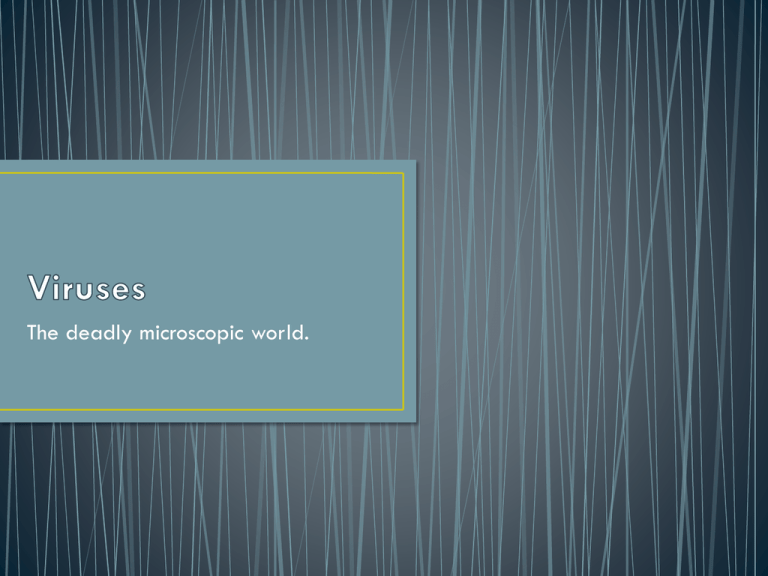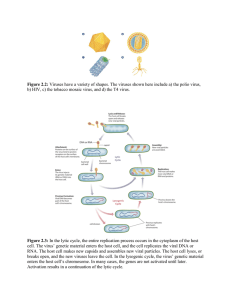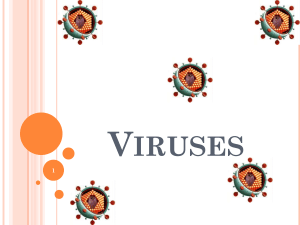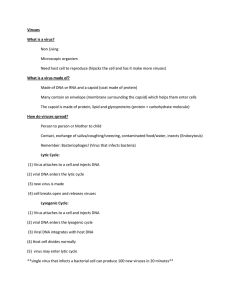Present 17
advertisement

The deadly microscopic world. • Nucleic acid within a protein coat • Jenner – smallpox vaccine • Non-living • No metabolism • Cannot replicate without a host • No scientific name, instead family names Influenza virus • Viruses that infect bacteria – bacteriophage • General Characteristics: • Nucleic acid – either RNA or DNA • Outer protein capsid • Optional features for protection • Envelope, spikes, slime layers Capsid protein Tail Tail fibers DNA or RNA • Prior to replication, virus must enter cell • Protein on virus interlock with surface markers on cells • Each virus has specific cell to “dock” with • EX: polio virus attaches to nerve cells • Lytic 1A. Virus attaches to cell 2A. Inserts DNA 3A. Replication of viral parts 4A. Assembly of new viruses 5A. Cell lyses • Lysogenic 1B. Virus attaches to cell 2B. Inserts DNA 3B. DNA integrates into host DNA - prophage 4B. Cell replicates normally with viral DNA altering protein synthesis 5B. Viral DNA comes out of the host DNA 6B. Begin Lytic Cycle • • • • Inhibit protein synthesis of host Open lysosomes Bind membranes together Create a toxic level of proteins The human body protects itself from viruses using antibodies and fever. Viruses prefer body temperature. Which of these diseases is likely to be caused by a lytic virus? Characteristics of some Viral Diseases Disease Symptoms Incubation Measles Rash, Fever 9-11 days Shingles Pain, itching on skin Years Warts Bumpy area on skin Months Influenza Body aches, fever, runny nose 1-4 days HIV fatigue, weight loss, fever 2-5 years Smallpox • Last seen in 1977 • Eradicated by WHO due to obvious symptoms and short life cycle • CDC and Moscow • Self-replicating Chicken Pox •Fluid filled blisters •Itching and burning •Common in kids •Vaccine to prevent Herpes zoster – shingles •Reactivated chicken pox •Highly contagious •Viral DNA remains in neurons, dormant •Pain, fever, skin lesions, pus filled spots •Can be due to sun, stress, fever, trauma, but main cause unknown Untreated shingles Herpes simplex 2 • Genital herpes • Virus lives in bottom of the spine • Same reactivation • Congenital herpes in newborns • Tingling, pain during urination, thick discharge, fluid filled vesicles • Found in 25 mil Americans Cold Sores •Herpes simplex •Virus lives in a nerve in face •Reactivated similar to shingles •Fever, sore throat, mouth pain, edema Untreated cold sores HIV • Retrovirus RNA DNA •Reverse transcriptase • Fluid transmission • Enters immune system by endocytosis into WBC • Prevents WBC from making a receptor (CD4) that normally detects pathogens • Symptoms treated with drug cocktail HIV • Exposure symptoms – headache, sore throat, occasional rash • Upon reactivation – rapid weight loss, dry cough, night sweats, unexplained fatigue, white spots in mouth, memory loss Kaposi’s Sarcoma – HIV side affect Burkitt’s Lymphoma – HIV Side Affect Rabies • Virus lives in salivary glands of animal • Virus destroys the nerves • Produces Negri bodies in brain • Initial symptoms – tingling and cold around bite, nervous • Phase II – anxiety, photophobia, arrhythmia, pupil dilation, difficulty swallowing • Gamma globulin treatment Mononucleosis • Fluid transmission • “kissing disease” • Infects WBC’s • Enlarged lymph nodes, swollen spleen, sore throat, nausea, weakness, fatigue • Can last up to 6 wks • Remains latent in nerves Measles • Highly contagious • Respiratory droplet spread • Nasal discharge, dry cough, fever, headache, pink eye, pink lesions, ear infection • Targeted for eradication • MMR vaccine Viral Hepatitis B • Initially asymptomatic • 1-3 month incubation • Fever, loss of appetite, pain, nausea, fatigue, jaundice, swollen liver • 3 step vaccine Hanta Virus • Deermice and ticks • No human to human • 2-3 day incubation • Cough, pulmonary edema, hemorrhaging, renal failure, achy muscles • 60% death rate Ebola • 93% death rate • Hemorrhagic fever • High temperature • Blood from orifices Scott lives on a farm in the country. He started feeling sick with flu-like symptoms. After a couple of days, his pupils became dilated and he had difficulty swallowing. His parents rushed him to the emergency room. X-rays revealed that Scott has small lesions forming on his brain. He also had an animal bite on his lower leg. rabies Mary is a 23 year old college student who went to the doctor after several weeks of general sickness. She complained of fatigue, chills, sweating at night, a continuous cough, and slight diarrhea. It was noted during the exam that her glands under her arms and in her neck were swollen. The doctors performed a blood test. HIV A child, age 7, came home from school complaining of a sore throat. Her mom took her fever, which was 1020F. The child was taken to the doctor after a couple of days with no improvement. The doctor noticed that she was developing a pink rash and seemed to have an ear infection. She had not been vaccinated with the MMR. What illness does this child likely have? measles • Steroids given if severe – boost immune function • Usually cause fever • Some vaccinations are weakened forms of actual virus • Many viruses stay in your system even after recovery A B J







